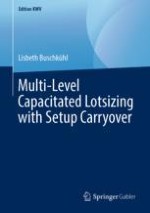2008 | Buch
Über dieses Buch
Lotsizing problems are found in every company, which produces various items on resources with scarce capacities. In general, the objective is to find production plans, which meet demand with the resources` given capacities and at minimal costs. However, there is a great variety of company-specific lotsizing problems due to the complexity of the underlying production processes. Both standard MRP-systems and modern Advanced Planning Systems fail to provide adequate solutions. Instead, they most often compute production plans, which are not feasible in practice.
In this book new lotsizing models are presented for multi-stage production systems with general product structures, dynamic demand, setup times and lead times. They are extended to cover production on parallel machines. An iterative solution procedure is presented, which generates feasible production plans within seconds of computation time.
Potential readership includes scholars of supply chain management and production planning, interested students in these areas as well as practitioners involved in production planning.
Anzeige
